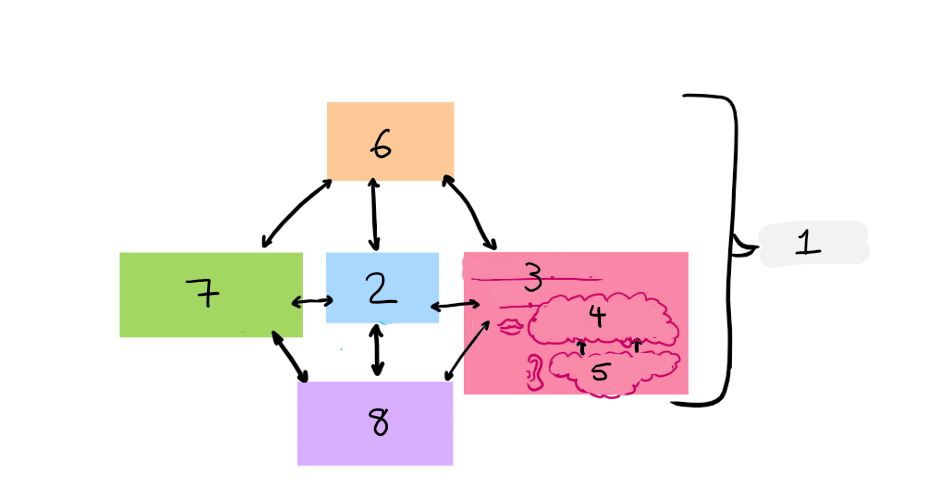Working Memory Model
1/14
There's no tags or description
Looks like no tags are added yet.
Name | Mastery | Learn | Test | Matching | Spaced |
|---|
No study sessions yet.
15 Terms
Working Memory Model
What is a dual task paradigm?
two tasks preformed simultaneously → worse when same type of WM is used for both bcs interference occurs + WM = overloaded, better when diff types used
Working Memory Model
What is the WMM?
Created by Baddeley and Hitch bcs of issues w/ MSM
Describes internal structures/processes involved in STM, + info we can process/hold in our conscious attention to work on a task

Working Memory Model
Fill in the blanks:
STM
Episodic buffer
phonological loop
articulatory control system (ACS)
phonological store (PS)
Central executive
Visuospatial sketch pad
Working Memory Model
Describe the central executive: (6 to remember) + mnemonic
Overall control, eg: problem solving, decision making, attention
Controls flow of info b/w ‘slave systems’
Can process any info from any sense
Can re-direct attention from one slave system, to another
Limited capacity
Plays major role in planning + synthesizing info
Only Few People Really Love Pea Soup
Working Memory Model
Describe the phonological loop (4 to remember)
Processing + temporary storage for auditory info, allows for maintenance rehearsal w/
ACS - (inner voice) for rehearsal
PS - (inner ear) for storage
limited capacity
Working Memory Model
Describe the episodic buffer: (4 to remember)
Added to WMM in 2000
Integrates all types of data processed by other stores (eg: auditory, visual, spatial) SO described as storage component of CE
Links info from the CE, the slave systems, and LTM
Limited capacity
Working Memory Model
Describe the visuospatial sketch pad: (4)
‘inner eye’
limited capacity (4-5 chunks (Baddeley))
temporary storage + processing system for visual/spatial info
Divided into ‘visual cache-storage’ + ‘inner scribe’
Working Memory Model
What are the ‘slave systems’?
Visuospatial sketch pad
Phonological loop
Working Memory Model
Evaluation: support for phonological loop + visuospatial sketchpad being separate
KF’s STM = damaged after motorcycle accident → could recall verbal but not visual info immediately after accident → supports WMM claim that verbal + verbal info is processed separately BUT not conclusive bcs case study
Working Memory Model
Evaluation: support for phonological loop
Baddeley et al (1975) → Ps remembered more short-words than long (the word length effect), when given interference task, preventing rehearsal (eg: counting backwards in 3s) → word-length effect disappeared → supports idea that phonological loop has limited duration
Working Memory Model
Evaluation: support using dual task paradigm
Baddeley + Hitch (1976) used dual task paradigm w/ Ps to demonstrate existence of different stores → found it hard to do dual tasks using same part of WMM but easy if used different aspects of the WMM → suggests STM = comprised multiple stores → supports WMM
Working Memory Model
Evaluation: idiographic/nomothetic
Uses both idiographic and nomothetic methods to provide support for the model → case studies (eg: KF) and experiments (eg: Baddeley et al (1975), Baddeley + Hitch) → strengthens model bcs there are in-depth case studies and general experiments which support the idea of the WMM
Working Memory Model
Evaluation: elaborates on STM from MSM
MSM views STM as singular, unitary store, so WMM elaborating on this increases insight/understanding of STM → can be used for further research/developing practical applications
Working Memory Model
Evaluation: practical application
Klingberg (2005): 42 children w/ ADHD, played a computer game designed to improve WM, two groups: 1) increasing task difficulty as WM improved, 2) constant task difficulty → increasing difficulty: sig. improvements to WM capacity, reasoning abilities, + decreased displays of behavioural symptoms → can be used to help reduce difficulties in WM associated w/ ADHD → improves quality of life
BUT
Children’s brains = more plastic → hard to generalise to gen pop
Working Memory Model
Evaluation: CE = too vague
doesn’t clearly define what it is → Eysenck (1986) claimed that a single CE might be as inaccurate as a single STM → almost impossible to study it: difficult to quantify/observe/measure → issue bcs not empirically tested, so can’t be falsified → unscientific